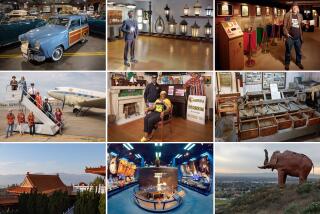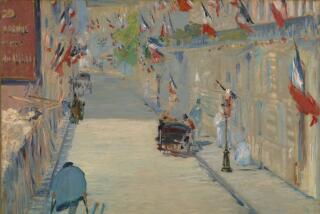Here’s the Book on Contemporary France
- Share via
Sidra Stich knows her way around the art world. A widely traveled art historian and curator of modern and contemporary art, she was chief curator of the University Art Museum at UC Berkeley from 1984 to 1991, and she has organized dozens of exhibitions, including a retrospective of Yves Klein’s work that appeared in major museums in Germany, England and Spain during 1994-95.
Stich lives in San Francisco, but she has done a great deal of work in Europe, so she might be expected to be an authority on the contemporary art scene there. As it turns out, she is--but only because she became frustrated with trying to find new art and architecture on her travels.
The problem eventually inspired her to launch a series of paperback guidebooks, “art*Sites,” which has made its debut with “France: Contemporary Art + Architecture Handbook.” Published by art*Sites in San Francisco and priced at $19.95, the 288-page inaugural volume is a survey of attractions in Paris, its environs and the provinces, accompanied by 80 illustrations and 20 maps. Prominent museums and avant-garde galleries are noted, but so is an astonishing array of little-known public artworks, unusual buildings and art-related hot spots.
Making her way around Paris, Stich points out a tomb sculpture in the shape of a giant cat by artist Niki de Saint-Phalle in the Montparnasse Cemetery, a bird-call sound piece by Louise Lawler at the Lafayette traffic circle, a canyon-like water sculpture by Gerard Singer at Bercy Park and additional public pieces by Arman, Pol Bury, Jean-Pierre Raynaud and Giulio Paolini.
Among Parisian buildings that catch her eye are a public housing and post office complex designed by Aldo Rossi, the Bastille Opera by Carlos Ott and several projects by Pritzker Prize-winning architect Christian de Portzamparc. Stich also provides tips on art book stores and--for readers with a sweet tooth--the city’s “best pastry shop,” Gerard Mulot.
Flipping through the book, one finds many surprises. The section on Lyon features underground parking garages designed by artists. The most spectacular example is Daniel Buren’s “Direction Above Below, Sculpture in Place and in Movement,” a cylindrical form with arched openings that spiral down the six-story structure. A huge mechanized mirror--which rotates according to the speed of cars going up and down the ramps--is installed at the bottom of the garage to accentuate the depth of the cylinder and reflect the lighted arches. After describing the “sensation of an endless, twisting, sparkling screw,” Stich advises readers to check out the periscope on the plaza of the garage, which provides a view of the cylinder from its center.
Moving on to the city of Lille, Stich spotlights Portzamparc’s Credit Lyonnais Tower, a 20-story bank office building in the shape of a high-backed chair. For those who journey to the Ile de Vassiviere, near Limoges, she suggests visiting a large sculpture park with 21 ambitious works, including a stone wall partly submerged in water by Andy Goldsworthy.
“It’s really difficult to find interesting things that are related to contemporary culture when you go to a place you are not very familiar with,” Stich said, reflecting on the genesis of her art-oriented travel books. “Traditional guidebooks generally list only conventional tourist spots and major museums. They may include museums that focus on modern art, but not all of them.”
Finding alternative spaces and other adventurous outposts is “unbelievably impossible,” she said. Visitors who want to catch up with public artworks and new architecture must comb through periodicals and consult books on individual artists. As for commercial galleries, if listings are available, they tend to be indiscriminate and uninformative, she said.
Stich isn’t afraid to ask for advice on where to go and what to see, but that approach is ineffective. “Even if you ask informed people on the spot, they are not going to remember a lot of things,” she said, “so for a long time I had wished for a resource where you could find a broad spectrum of exciting things. I finally thought, well, why not do this myself?”
The idea struck at a moment when Stich was looking for a new project. “I loved curating, but I was getting a little burned out by the politics of museums--actually more than a little, a lot,” she said. “I was trying to figure out how to use my background to do something I enjoyed that would be useful to other people as well. Since I wanted [a guide to contemporary art and architecture] I thought maybe other people did too. When I started asking around, it turned out that there was nothing like that, and a lot of people seemed to think they would like to have one.”
She started with France because it’s relatively familiar territory for her and a popular tourist destination. But she also thought there was much to be discovered. “Decentralization has been going on in France for 15 or 20 years, but most people still only go to Paris,” she said. “They think that’s where it’s happening, but you actually find much more exciting, interesting things elsewhere around the country.”
*
A brief introduction to the book acquaints readers with French cultural authorities, regional art centers, recent art movements and developments such as new towns, or satellite cities, launched in the 1960s to relieve urban congestion. And for Francophiles who plan to celebrate the millennium in Paris, Stich suggests attending the opening of the renovated Georges Pompidou Center at midnight on Dec. 31.
She geared up for the first book in her new series by doing extensive research at home, compiling tidbits from books and magazines, then took “an intense three-month research trip” in France. “I asked questions and did lots of detective work and exploring,” she said.
Sifting through her findings, she made discriminating choices, selecting sites that she deemed unique or particularly interesting. “I didn’t want to get into a nay-saying thing, nor did I want to send people off to see things that aren’t worthwhile,” she said.
Writing and publishing the first book was “a learning process” and required coping with “an overwhelming amount of detail,” she said. Much more than a list, the volume on France provides colorful descriptions of artworks and their surrounding neighborhoods as well as precise instructions about how to find them.
But now that the book on France is making its way into the suitcases of travelers, the second volume of her series--on Britain and Ireland--is nearly finished. “It will be out in January or February,” Stich said. Then she’ll do a book on Spain and Portugal.
Planning to publish at least one book a year, she also expects to venture into Asia and the Americas, with the help of other writers. “We will cover all the major centers of contemporary art,” she said. Meanwhile, each book will be updated every three years.
“art*Sites” is an ambitious project that’s only beginning to gather steam--and become even more complicated. But in terms of getting the word out, Stich’s job is likely to get easier. “The big thing in getting this off the ground is letting people know that it exists,” she said. “You don’t go looking for an art travel guide if you’ve never seen one or heard that there is such a thing.”
More to Read
The biggest entertainment stories
Get our big stories about Hollywood, film, television, music, arts, culture and more right in your inbox as soon as they publish.
You may occasionally receive promotional content from the Los Angeles Times.










